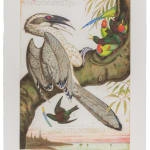-
Artworks


WALTON FORD
Swadeshi-cide, 1998Etching and aquatint with drypoint and hand-colouring.
Signed, dated and numbered in an edition of 50.
Printed on white Somerset Satin paper by Peter Pettengill at Wingate Studio, Hinsdale, New Hampshire.
Published by Blue Heron Press Inc., New York.Plate: 91.4 x 61 cm (36 x 24 in)
Sheet: 111.8 x 78.7 cm (44 x 31 in)“ln his quest for lndia’s independence from Great Britain, Mahatma Gandhi chose Swadeshi homespun lndian cotton as his symbol, Walton Ford’s image, Swadeshi-cide metaphorically depicts how Gandhi’s goals for self-sufficiency have been thwarted in the ensuing post-inde-pendence decades. ln Hindi, cide means kill; this is underscored by the extended title “patents pending” and the Hindi phrase “stop thief.” Ford here highlights the corruption that has made traditional agrarian practices illegal in lndia. For instance, lndia once had many distinctive strains of rice, each adapted to local climatic and geographic conditions.
Farmers would save a portion of each crop to use as seed forthe next year. The government allowed foreign companies to patent native rice strains; hybridized, these genetically sterilized seeds were sold to the farmers at the insistence of the government. The seeds were incompatible with local conditions, and farmers’ crops often failed, forcing them to purchase more seed for each futile crop. (Not self-sufficiency as conceived by Gandhi.)
(The native neem tree was the source of a natural pesticide any farmer could easily extract. After the rights to the genetic material and to the process of pesticide extraction had been sold to a multination-al company, a farmer could be fined for using this centuries-old process without paying for the privilege.)
Walton Ford tells this complex story with beautifully depicted birds in a rural lndian landscape. A large Common Grey Hornbill represents lndia. She sits on a branch of a neem tree in which she has a nest. She is surrounded by a sycophantic flock of indigenous and foreign bids – native Blossom-headed Parakeets and European Starlings feeding her with tempting morsels to gain control of her centuries-old nest.”
– David Kiehl
1of 6



